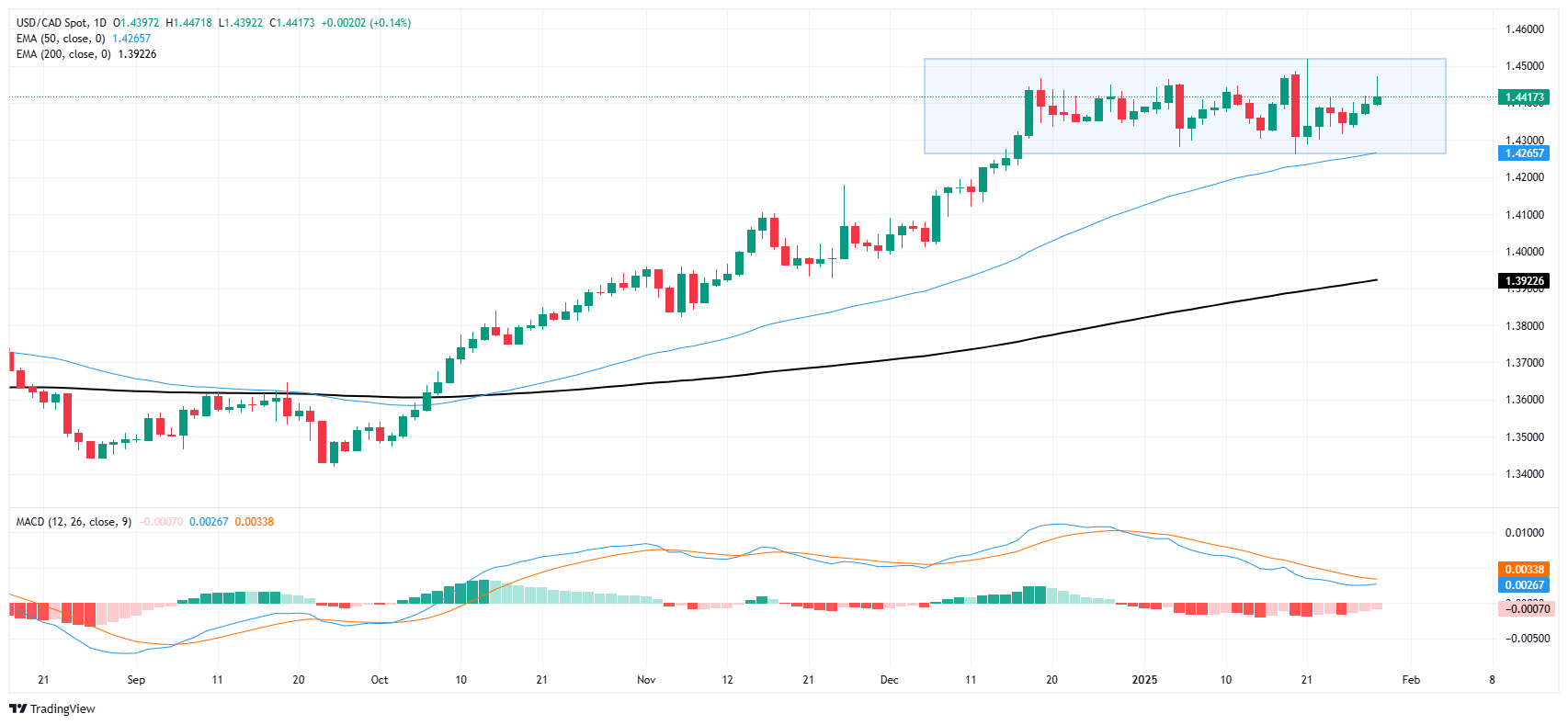- The Canadian Dollar lost 0.25% against the Greenback on Wednesday.
- The Bank of Canada cut interest rates by another 25 bps, to 3%.
- The BoC also announced the end of its quantitative tightening program.
The Canadian Dollar shed one-quarter of one percent against the Greenback on Wednesday, falling back after the Bank of Canada (BoC) slashed another 25 bps from interest rates, bringing the BoC’s main reference rate down to 3.0%. The Canadian interest rate peaked at 5% in July of 2023, and the BoC’s latest rate cut follows two back-to-back jumbo cuts of 50 bps in October and December of last year.
The Bank of Canada also announced the end of its quantitative tightening program, and is expected to restart asset purchases in early March. However, BoC Governor Tiff Macklem pulled back from the brink, saying that the BoC isn’t expecting to full-on restart quantitative easing programs immediately. The looming threat of widespread trade tariffs from US President Donald Trump is definitely weighing on the BoC, and rate swap markets are pricing in nearly-even odds that the Canadian central bank will deliver another 25 bps rate cut in March.
Daily digest market movers: Canadian Dollar sheds weight after BoC rate cut
- Despite getting knocked back post-BoC rate cut, the Canadian Dollar is still treading water within its recent range, keeping USD/CAD hobbled near the 1.4400 handle.
- With the CAD’s interest rate differential against the US Dollar set to widen further heading into Q2, Loonie bulls have limited room to run.
- Tariffs are the looming threat to the BoC’s policy stance in 2025.
- BoC policymakers have brushed off the Loonie sitting at multi-year lows against the USD for the time being, but continued declines may spark policy adjustments moving forward.
- The BoC also snuck in a slight upside revision to inflation forecasts, now see annualized inflation metrics to hold slightly above the 2.0% target through 2026.
- BoC Governor Macklem: Tariffs threat weighed on the bank's decision
Canadian Dollar price forecast
The Canadian Dollar has shed some weight against the US Dollar for three consecutive trading days, falling back around four-tenths of one percent through the first half of the trading week and bolstering USD/CAD back above the 1.4400 handle. The pair has been in a rough sideways grind for over six weeks after the Loonie fell to multi-year lows against the Greenback and USD/CAD tapped 1.4500 for the first time since the pandemic.
USD/CAD price action remains hobbled in a choppy flat channel between 1.4300 and 1.4500, with bids continuing to swirl around 1.4400 in back-and-forth chart momentum. The pair is overall poised for a topside break into chart paper above 1.4500, but a pullback below the 50-day Exponential Moving Average (EMA) rising into 1.4270 could see an extended bearish slide.
USD/CAD daily chart
Canadian Dollar FAQs
The key factors driving the Canadian Dollar (CAD) are the level of interest rates set by the Bank of Canada (BoC), the price of Oil, Canada’s largest export, the health of its economy, inflation and the Trade Balance, which is the difference between the value of Canada’s exports versus its imports. Other factors include market sentiment – whether investors are taking on more risky assets (risk-on) or seeking safe-havens (risk-off) – with risk-on being CAD-positive. As its largest trading partner, the health of the US economy is also a key factor influencing the Canadian Dollar.
The Bank of Canada (BoC) has a significant influence on the Canadian Dollar by setting the level of interest rates that banks can lend to one another. This influences the level of interest rates for everyone. The main goal of the BoC is to maintain inflation at 1-3% by adjusting interest rates up or down. Relatively higher interest rates tend to be positive for the CAD. The Bank of Canada can also use quantitative easing and tightening to influence credit conditions, with the former CAD-negative and the latter CAD-positive.
The price of Oil is a key factor impacting the value of the Canadian Dollar. Petroleum is Canada’s biggest export, so Oil price tends to have an immediate impact on the CAD value. Generally, if Oil price rises CAD also goes up, as aggregate demand for the currency increases. The opposite is the case if the price of Oil falls. Higher Oil prices also tend to result in a greater likelihood of a positive Trade Balance, which is also supportive of the CAD.
While inflation had always traditionally been thought of as a negative factor for a currency since it lowers the value of money, the opposite has actually been the case in modern times with the relaxation of cross-border capital controls. Higher inflation tends to lead central banks to put up interest rates which attracts more capital inflows from global investors seeking a lucrative place to keep their money. This increases demand for the local currency, which in Canada’s case is the Canadian Dollar.
Macroeconomic data releases gauge the health of the economy and can have an impact on the Canadian Dollar. Indicators such as GDP, Manufacturing and Services PMIs, employment, and consumer sentiment surveys can all influence the direction of the CAD. A strong economy is good for the Canadian Dollar. Not only does it attract more foreign investment but it may encourage the Bank of Canada to put up interest rates, leading to a stronger currency. If economic data is weak, however, the CAD is likely to fall.
Information on these pages contains forward-looking statements that involve risks and uncertainties. Markets and instruments profiled on this page are for informational purposes only and should not in any way come across as a recommendation to buy or sell in these assets. You should do your own thorough research before making any investment decisions. FXStreet does not in any way guarantee that this information is free from mistakes, errors, or material misstatements. It also does not guarantee that this information is of a timely nature. Investing in Open Markets involves a great deal of risk, including the loss of all or a portion of your investment, as well as emotional distress. All risks, losses and costs associated with investing, including total loss of principal, are your responsibility. The views and opinions expressed in this article are those of the authors and do not necessarily reflect the official policy or position of FXStreet nor its advertisers. The author will not be held responsible for information that is found at the end of links posted on this page.
If not otherwise explicitly mentioned in the body of the article, at the time of writing, the author has no position in any stock mentioned in this article and no business relationship with any company mentioned. The author has not received compensation for writing this article, other than from FXStreet.
FXStreet and the author do not provide personalized recommendations. The author makes no representations as to the accuracy, completeness, or suitability of this information. FXStreet and the author will not be liable for any errors, omissions or any losses, injuries or damages arising from this information and its display or use. Errors and omissions excepted.
The author and FXStreet are not registered investment advisors and nothing in this article is intended to be investment advice.
Recommended content
Editors’ Picks

EUR/USD dips below 1.1000 as Trump authorizes 90-day pause on tariffs
EUR/USD retreated below the 1.1000 mark on headlines indicating that United States President Donald Trump authorized a 90-day pause on non-retaliating countries. The pause applies to reciprocal and 10% tariffs, effective immediately, according to a Truth Social post. FOMC Minutes indicated increasing uncertainty.

GBP/USD eases further on tariffs pause announcement, USD still weak
GBP/USD's correction seems to have met a decent contention around the 1.2750 zone so far on Wednesday, as investors continue to assess the ongoing US-China trade war. US doubles the bet, announced 125% levies on Chinese imports.

Gold recedes to $3,050 on Trump's headlines
Gold prices now give away part of their advance and revisit the $3,050 zone per troy ounce after President Trump announced a 90-day pause on reciprocal and 10% tariffs. FOMC Minutes passed unnoticed as optimism returned.

Dow Jones Industrial Average rockets 6% higher on tariff suspension
The Dow Jones Industrial Average (DJIA) skyrocketed on Wednesday, surging over 6% on the day and returning to the 40,000 handle after the Trump administration announced yet another pivot on its own tariff policies.

Tariff rollercoaster continues as China slapped with 104% levies
The reaction in currencies has not been as predictable. The clear winners so far remain the safe-haven Japanese yen and Swiss franc, no surprises there, while the euro has also emerged as a quasi-safe-haven given its high liquid status.

The Best brokers to trade EUR/USD
SPONSORED Discover the top brokers for trading EUR/USD in 2025. Our list features brokers with competitive spreads, fast execution, and powerful platforms. Whether you're a beginner or an expert, find the right partner to navigate the dynamic Forex market.



